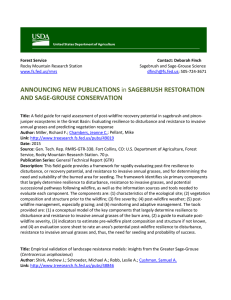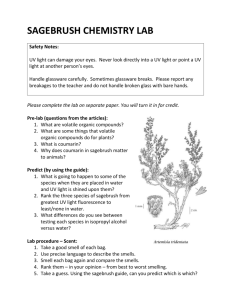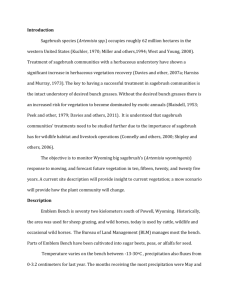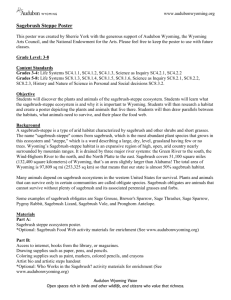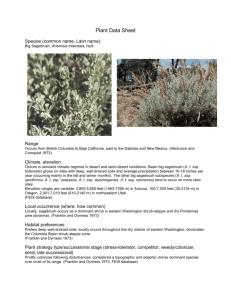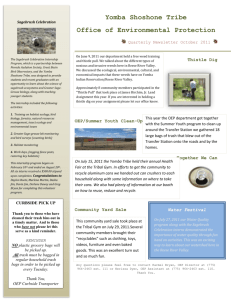Document 11785967
advertisement
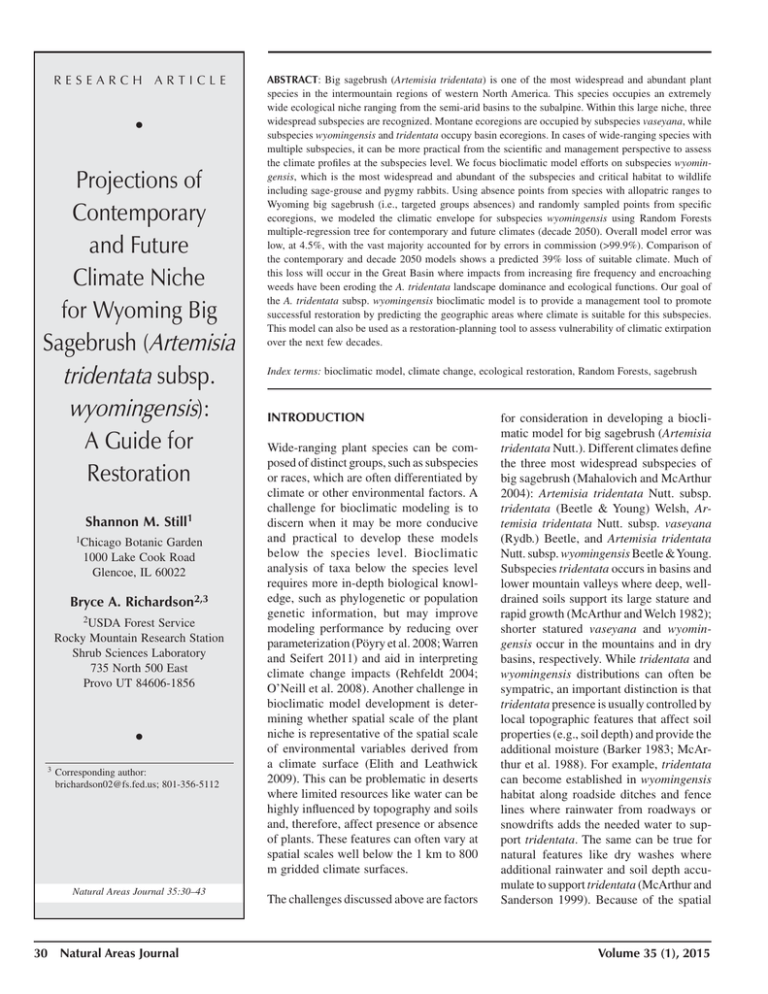
RESEARCH ARTICLE • Projections of Contemporary and Future Climate Niche for Wyoming Big Sagebrush (Artemisia tridentata subsp. wyomingensis): A Guide for Restoration Shannon M. Still1 1Chicago Botanic Garden 1000 Lake Cook Road Glencoe, IL 60022 Bryce A. Richardson2,3 2USDA Forest Service Rocky Mountain Research Station Shrub Sciences Laboratory 735 North 500 East Provo UT 84606-1856 • 3 Corresponding author: brichardson02@fs.fed.us; 801-356-5112 Natural Areas Journal 35:30–43 30 Natural Areas Journal ABSTRACT: Big sagebrush (Artemisia tridentata) is one of the most widespread and abundant plant species in the intermountain regions of western North America. This species occupies an extremely wide ecological niche ranging from the semi-arid basins to the subalpine. Within this large niche, three widespread subspecies are recognized. Montane ecoregions are occupied by subspecies vaseyana, while subspecies wyomingensis and tridentata occupy basin ecoregions. In cases of wide-ranging species with multiple subspecies, it can be more practical from the scientific and management perspective to assess the climate profiles at the subspecies level. We focus bioclimatic model efforts on subspecies wyomingensis, which is the most widespread and abundant of the subspecies and critical habitat to wildlife including sage-grouse and pygmy rabbits. Using absence points from species with allopatric ranges to Wyoming big sagebrush (i.e., targeted groups absences) and randomly sampled points from specific ecoregions, we modeled the climatic envelope for subspecies wyomingensis using Random Forests multiple-regression tree for contemporary and future climates (decade 2050). Overall model error was low, at 4.5%, with the vast majority accounted for by errors in commission (>99.9%). Comparison of the contemporary and decade 2050 models shows a predicted 39% loss of suitable climate. Much of this loss will occur in the Great Basin where impacts from increasing fire frequency and encroaching weeds have been eroding the A. tridentata landscape dominance and ecological functions. Our goal of the A. tridentata subsp. wyomingensis bioclimatic model is to provide a management tool to promote successful restoration by predicting the geographic areas where climate is suitable for this subspecies. This model can also be used as a restoration-planning tool to assess vulnerability of climatic extirpation over the next few decades. Index terms: bioclimatic model, climate change, ecological restoration, Random Forests, sagebrush INTRODUCTION Wide-ranging plant species can be composed of distinct groups, such as subspecies or races, which are often differentiated by climate or other environmental factors. A challenge for bioclimatic modeling is to discern when it may be more conducive and practical to develop these models below the species level. Bioclimatic analysis of taxa below the species level requires more in-depth biological knowledge, such as phylogenetic or population genetic information, but may improve modeling performance by reducing over parameterization (Pöyry et al. 2008; Warren and Seifert 2011) and aid in interpreting climate change impacts (Rehfeldt 2004; O’Neill et al. 2008). Another challenge in bioclimatic model development is determining whether spatial scale of the plant niche is representative of the spatial scale of environmental variables derived from a climate surface (Elith and Leathwick 2009). This can be problematic in deserts where limited resources like water can be highly influenced by topography and soils and, therefore, affect presence or absence of plants. These features can often vary at spatial scales well below the 1 km to 800 m gridded climate surfaces. The challenges discussed above are factors for consideration in developing a bioclimatic model for big sagebrush (Artemisia tridentata Nutt.). Different climates define the three most widespread subspecies of big sagebrush (Mahalovich and McArthur 2004): Artemisia tridentata Nutt. subsp. tridentata (Beetle & Young) Welsh, Artemisia tridentata Nutt. subsp. vaseyana (Rydb.) Beetle, and Artemisia tridentata Nutt. subsp. wyomingensis Beetle & Young. Subspecies tridentata occurs in basins and lower mountain valleys where deep, welldrained soils support its large stature and rapid growth (McArthur and Welch 1982); shorter statured vaseyana and wyomingensis occur in the mountains and in dry basins, respectively. While tridentata and wyomingensis distributions can often be sympatric, an important distinction is that tridentata presence is usually controlled by local topographic features that affect soil properties (e.g., soil depth) and provide the additional moisture (Barker 1983; McArthur et al. 1988). For example, tridentata can become established in wyomingensis habitat along roadside ditches and fence lines where rainwater from roadways or snowdrifts adds the needed water to support tridentata. The same can be true for natural features like dry washes where additional rainwater and soil depth accumulate to support tridentata (McArthur and Sanderson 1999). Because of the spatial Volume 35 (1), 2015 context of these features (<100 m2), distinguishing the environmental components that support tridentata is beyond the scope of bioclimatic modeling. Hybridization among subspecies is another concern that could affect bioclimatic modeling results. Big sagebrush subspecies are known to form hybrid swarms along ecotones at the foot of mountains (McArthur et al. 1988; Wang et al. 1997) and also between wyomingensis and vaseyana of the same ploidy (McArthur and Sanderson 1999; Richardson et al. 2012). In such cases, presence or absence data that does not assess hybrid characters could confound a subspecies bioclimatic model. Another consideration in bioclimatic model development of big sagebrush is the utility for ecological restoration. Successful restoration requires deploying the appropriately adapted seed into a suitable environment. A primary step in this process for big sagebrush is identifying subspecies climate niche, and whether it will migrate in a changing climate. Among the subspecies, wyomingensis warrants the most attention for ecological restoration. This subspecies occupies the warmest and driest areas of the species range—areas that are more susceptible to wildfire and cheatgrass (Bromus tectorum L.) invasion (Chambers et al. 2007; Bradley 2010; Chambers et al. 2013). The degradation of these sagebrush ecosystems to weeds is a key factor in the loss of sage-grouse habitat (Crawford et al. 2004). A contemporary and future bioclimatic model of wyomingensis would provide, at a broad scale, a means to assess areas where this subspecies would be the most suitable for restoration. Previous bioclimatic models of big sagebrush have utilized a broader group of taxa. Bradley (2010) used land surface data (GAP analysis) of two subspecies of big sagebrush, tridentata and wyomingensis, and other sagebrush species that inhabit intermountain basin communities of the western United States (e.g., low sagebrush, A. arbuscula Nutt.; and black sagebrush, A. nova A. Nelson) in developing a bioclimatic model and risk mapping of cheatgrass invasion for the state of Nevada. Schlaepher et al. (2012) used a similar approach with the addition Volume 35 (1), 2015 of subspecies vaseyana in developing a bioclimatic model, and its comparison to a mechanistic model developed from ecohydrological data. Here, our bioclimatic modeling efforts are focused on defining the climate niche of a single subspecies, Wyoming big sagebrush, by developing a data set of occurrences, as well as a data set of absence points from species that occupy adjacent plant communities. Our goal is to develop a bioclimatic model for Wyoming big sagebrush that would provide a broad-scale reference for ecological restoration, including a management tool to promote successful restoration by predicting geographic areas suitable for this subspecies, and a planning tool to assess vulnerability of climatic extirpation over the next few decades. MATERIALS AND METHODS Samples and Data Collection The climate model was developed from presence and absence points. Presence data, consisting of 131 occurrence points (Appendix 1), were derived principally from previous studies: McArthur and Sanderson (1999), Richardson et al. (2012), and Wilt et al. (1992). Techniques used to determine subspecies are described within each publication, but in nearly all cases flow cytometry or chromosome counts were used to confirm ploidy. The exception is Wilt et al. (1992), who use morphology and an assessment of phenolic compounds. Absence data was derived through several sources and contained 4464 points consisting of both target-group absences (TGA) and randomly selected background points. TGA, localities for other taxa that do not co-occur with the target species, have been used successfully in species distribution modeling (Mateo et al. 2010). A total of 3964 TGA were derived from previous studies (Richardson and Meyer 2012; Esque et al. unpubl. data), the USDA Forest Service, Forest Inventory and Analysis Program (FIA) (Bechtold and Patterson 2005), and the Consortium of California Herbaria (CCH) (data provided by the participants of the Consortium of California Herbaria [ucjeps.berkeley.edu/consortium]). The taxa used in TGA are listed in Appendix 2, along with their respective sources. A total of 500 background points were randomly selected from a group of three Level III Ecoregions (Omernick 1987). These ecoregions, Nebraska Sandhills, Northwestern Glaciated Plains, and Southwest Tablelands were chosen to provide additional absence points in areas lacking TGA to fill out the range of climatic variation. Climatic Data The geographic extent for both models and projections was set from 30° N to 55° N latitude and from 130° W to 100° W longitude to incorporate the entire range of possible sagebrush habitat. The baseline climatic data set was acquired from WorldClim (Hijmans et al. 2005), comprising 19 bioclimatic (BIOCLIM) variables (Appendix 3) for present conditions (mean 1950–mean 2000) at 30 arc-second resolution, which is roughly 1 km2 at the equator. The BIOCLIM variables have been widely used in modeling work as variables that are biologically important for various species (Hijmans et al. 2005). Bioclimatic Model To model the climate-defined area of Wyoming big sagebrush, we estimated the likelihood that the climate was suitable across a large section of western North America. The estimate was derived from a climate profile, which is a multivariate description of the climatic niche. The climate profile was developed from bioclimatic models, that is, regressions of the presence and absence of a species on climate variables. The modeling techniques used here closely follow those of Rehfeldt et al. (2006) as explained in detail in Rehfeldt et al. (2009) and Crookston et al. (2010). The Random Forests classification tree of Breiman (2001), implemented in R 3.02 (R Core Team 2013) by Liaw and Wiener (2012) in the package “RandomForest,” was used to predict the presence or absence of species from the climate variables. The Random Forests algorithm constructs a set of classification trees from an input data set and outputs statistics that reflect the likelihood that the climate at a location Natural Areas Journal 31 is suitable for the species (Rehfeldt et al. 2009). The trees in aggregate are called a forest. The climate profile was built on 12 forests, each with 100 trees (i.e., decision trees). To create the trees, a majority of the data, usually around 64%, were used to create the model, and the remaining portion of the data set, the out-of-bag occurrence points, were used to test the model. The best-fitting model for each tree was built by comparing the out-of-bag error. Outof-bag errors are comprised of rates of errors in commission (where the model predicts an occurrence when no plant is present), and errors in omission (where the model predicts an absence when a species is actually present). To make predictions about presence of a species, each tree in the forest provides one vote to the classification of an observation. Because classification errors approach a limit as the number of trees in the forest increase, collinearity and over-parameterization are inconsequential (Breiman 2001). The approach has been shown to be robust and has worked for widely distributed species (Ledig et al. 2010). Assembling the presence-absence data for analysis requires satisfying Breiman’s recommendation that presence data be in reasonable balance with absence data (Breiman 2001). Each forest would need one data set, and each data set was prepared within which presence and absence points represented 40% and 60% of the total, respectively. For each of the data sets, the amount of presences was fixed at 40% to limit the amount of out-of-bag errors, which increase when the number of presence points is less than 40% of total points used in the model (Rehfeldt et al. 2006). All data sets contained all 131 presence points, each of which was weighted by a factor of two (each was included twice). This weighting assures that the resulting model is most robust for climates in which A. tridentata subsp. wyomingensis actually occurs (Rehfeldt et al. 2006; Ledig et al. 2010), and allows the number of absence points in the data set to be doubled, allowing for more complete sampling of the 32 Natural Areas Journal climatic variation. Each data set, therefore, included about 655 observations, with 262 observations with sagebrush, and about 393 observations without sagebrush. Absence points for the data sets were chosen in two steps. First, following the protocol of Rehfeldt et al. (2006), we defined an expanded climatic envelope as a 19-variable hypervolume corresponding to the climatic limits of distribution expanded by ±1 SD. Then, for each data set we randomly selected 40% of the points as absences from points that are within, and 20% of points were chosen randomly as absences from points outside, the climatic hypervolume detailed above. The number of forests was chosen by dividing the total number of absence points within the climate hypervolume described above by the number of presence points multiplied by two. Therefore, using 12 forests would assure that the probability would be high that all observations within the hypervolume would be used in at least one forest. The final predictor variables used were culled from the 19 BIOCLIM variables through a variable reduction process following Rehfeldt et al. (2006) and Rehfeldt et al. (2009). Based upon the out-of-bag error, the predictors were eliminated using the mean decrease in accuracy to judge variable importance until only one variable remained. Then the top seven variables were chosen to use as predictive variables to create the climate profile. The climatic data sets for the 2050s were acquired from WorldClim (Hijmans et al. 2005) and comprise the same bioclimatic variables as the contemporary data set. Climate surfaces for the 2050s (2040–2069) (Hijmans et al. 2005), derived from the IPCC (Intergovernmental Panel on Climate Change) 4th Assessment (IPCC 2007), were used to project the sagebrush bioclimate for this decade. To provide a consensus of 2050s projections, we used methods similar to Ledig et al. (2012) and Wang et al. (2012), where the outputs from five General Circulation Models (GCMs) are combined into an agreement map. GCMs included the A1b emission scenarios for the following five models: Canadian Center for Climate Modeling and Analysis (CCCMA CGCM3.1); Bjerkes Centre for Climate Research Norway (BCCR BCM2.0); Institute for Numerical Mathematics, Russia (INMCM3.0); Commonwealth Scientific and Industrial Research Organization (CSIRO MK3.0); and the Center for Climate System Research (University of Tokyo), National Institute for Environmental Studies, and Frontier Research Center for Global Change (JAMSTEC), Japan (MIROC3.2 medres). Information on the GCMs and emission scenarios can be found elsewhere (IPCC 2007). Agreement mapping of the five GCM–scenario combinations were performed in R using the RandomForest package as above. The threshold used to calculate suitable area for the contemporary and each of the future models was 0.5. For the 2050s, the predicted presence of sagebrush-suitable climate is mapped only where more than two of the five GCMs showed agreement. Mapping The climate profile from Random Forests analysis was mapped to the WorldClim climate grids. Each of the contemporary grid cells was evaluated for climatic suitability for sagebrush by the number of votes cast for the 100 trees in the 12 forests. A grid cell was considered to have suitable climate for sagebrush when the majority of the 1200 votes were cast in favor of the climate being suitable for sagebrush. This creates the bioclimatic model. Models were evaluated using the Area Under the Curve of Receiver-Operating Characteristic (AUC), a common measure for evaluating model fitness (Elith and Leathwick 2009). Ecoregional Assessment of Climate Niche Loss For both contemporary and future (2050s) projections of the bioclimatic model, the total area (km2) predicted to have suitable climate was calculated. We also calculated the area where both contemporary and future models overlapped (stable), the area that is suitable in the contemporary model but not suitable in the future model (contracting), and the area that is not suitable in the contemporary model but is suitable in the future model (expanding). Climate comparisons were made between two geographic regions that are predicted Volume 35 (1), 2015 to have the greatest losses in climate niche: the Great Basin and the Great Plains. We defined the regions by a combination of Omernik’s (1987) Level III Ecoregions. The Great Basin region is defined here by three of the ecoregions: Northern Basin and Range, Central Basin and Range, and Snake River Plain. The Great Plains region is here defined by several of the ecoregions: Middle Rockies, Southern Rockies, Northwestern Great Plains, Nebraska Sand Hills, High Plains, and Southwest Table Lands. The contemporary climate niche of Wyoming big sagebrush was split by whether the area is predicted to contract or remain stable by mid century. For these geographic areas, we compared Annual Dryness Index (ADI; mean annual precipitation / degreedays >5 oC), as calculated in Rehfeldt et al. (2006), and summer-winter precipitation ratio (SWP; warmest quarter precipitation [PWQ, BIO18] / coldest quarter precipitation [PCQ, BIO19]). These values were extracted in each raster grid cell for the Great Basin and Great Plains. Two-way ANOVA and Tukey’s HSD was used to test post-hoc mean differences between ecoregions and stable and contracting areas within each region. RESULTS Bioclimatic Model The average model AUC was excellent at 0.979. To balance commission, omission, and out-of-bag error, we chose a sevenvariable model with an out-of-bag error of 2.65%. Commission and omission rates for this model were 4.51% and 0.03%, respectively (Table 1). The climatic data set comprised seven bioclimatic variables (Table 2). The seven-variable model was chosen as being reasonably parsimonious while providing a buffer against reliance on single variables. The most important variable for this model was the mean temperature for the warmest quarter. The second most important variable was the annual mean temperature, and the third most important variable was temperature annual range. Of the seven variables used in the model, six were related to temperature. Mean annual precipitation was the only precipitation related variable and was the Volume 35 (1), 2015 Table 1. Confusion matrix of Wyoming big sagebrush (Artemisia tridentata subsp. wyomingensis) bioclimatic model showing the class error and number of observations classified by the Random Forests algorithm. Mean of the 12 Random Forests. ! sixth most important. "# ! Great Plains. Mapped Projections The contemporary climate niche predicts an area of nearly 108 million hectares (1,086,697 km2, Figure 1A) for Wyoming big sagebrush. By midcentury, a 39% reduction is predicted in this climate niche, totaling 66 million hectares (Figure 1B). Only 32% of the contemporary climate niche is stable by the middle of the century, while 67% of the contemporary climate niche is predicted to be lost and 28% will be gained. Regions predicted to be most vulnerable to climate change extirpation include the trailing edge (i.e., the southern periphery of the subspecies), the western Great Plains, and lower elevations of the Columbia and Great Basin. Regions that retain or gain climate niche include western Wyoming and eastern Idaho, higher elevations in the Great Basin and the northern Ecoregional Assessment of Climate Niche Loss The range of climatic conditions affecting the predicted loss of Wyoming big sagebrush differed among spatial and temporal scales (Appendix 4). The SWP and ADI were significantly different between ecoregions (Great Basin versus Great Plains; P < 0.0001) and within ecoregions between predicted stable and contracting areas. For both ecoregions, the stable areas of the climate niche had a lower ADI than the contracting areas (P < 0.0001). ADI values and differences between stable and contracting areas were much greater in the Great Basin than Great Plains (P < 0.0001) (Figure 2A and C). While small, the difference between stable and contracting Table 2. Climate variables used to predict the climate niche of Wyoming big sagebrush (Artemisia tridentata subsp. wyomingensis) bioclimatic model. Bioclimatic model variables are listed in order of importance. . / -, # 0 1 ! # 0 $ -. . " "" " "" " ""%+""""*"+" ""& ""%""'"-,,& " "" " " " ""%"""(+""*"+")& Natural Areas Journal 33 34 Natural Areas Journal Volume 35 (1), 2015 Figure 1. A) Mapped projection of the contemporary climate niche of Artemisia tridentata subsp. wyomingensis. Dark brown represents higher probability of occurrence (>0.75), whereas light brown represents lower probability (0.5 to 0.75). B) Mapped projection of the change in climate niche between contemporary and decade 2050. Dark purple represents areas that are predicted to have suitable climate for this subspecies in decade 2050 (i.e., stable or expanded), whereas light purple represents areas that are predicted to have unsuitable climates (i.e., contracted). areas of the Great Basin was significantly different for SWP (P < 0.0001), and significantly large differences in SWP were observed between stable and contracting areas (P < 0.0001) within the Great Plains (Figure 2B and D). DISCUSSION Model Development and Error It is well known that big sagebrush subspecies are defined by climate and that Wyoming big sagebrush occupies the warmest and driest extent of this species distribution (Mahalovich and McArthur 2004). To be successful in the restoration of sagebrush ecosystems, it is imperative that subspecies are placed in the appropriate climate. Previous published bioclimatic models have used broader taxonomic hierarchies based on the constraints of GAP analysis data to define sagebrush climate niche (Bradley 2010; Schlaepher et al. 2012). In this study, our goals were to produce a management tool for contemporary and future restoration of Wyoming big sagebrush. Data were acquired from known occurrences that span much of the range of the subspecies and have been taxonomically identified to subspecies. Our strategy was to frame this subspecies’ climate using targeted group absences using allopatric species in warmer and cooler climates (i.e., Coleogyne ramosissima Torr. and Cercocarpus ledifolius Nutt., respectively). A targeted group absence approach has been shown to be more accurate than pseudo-absences (Mateo et al. 2010). However, along the central and northern Great Plains, pseudoabsences were necessary because of the lack of suitable species to use as absence points. As with any bioclimatic model, some modeling error can be expected. Sources of errors could come from the environment, including soil and small-scale topographic features. Ecological interactions (e.g., plant competition), disturbance, and land use histories could also be sources of error. Nevertheless, the resulting model generated low errors in the prediction of which much were due to commission. Geographically, we suspect the preponderance of commisVolume 35 (1), 2015 Figure 2. Boxplots illustrating the range of values for Annual Dryness Index (ADI) and summer-winter precipitation ratio (SWP) for stable and contracting areas of the contemporary climate niche of Wyoming big sagebrush (Artemisia tridentata subsp. wyomingensis). Increasing values of ADI indicate decreasing precipitation and / or increasing accumulating temperatures >5 ̊C. Increasing values of SWP indicate a higher ratio of summer relative to winter precipitation. sion errors occurs along the Great Plains and the boundary with the Chihuahuan Desert in New Mexico (Figure 1A). In these regions, Wyoming big sagebrush is less dominant. This is likely due to a change to increasing summer versus winter precipitation that favors grasslands (Ogle and Reynolds 2004). Here, soils and topography become more of an important influence on presence and absence, and thus predictive error based on a climateonly model. Contemporary and Future Projections Comparisons of contemporary and future projections show considerable loss (39%) of Wyoming big sagebrush climate niche Natural Areas Journal 35 good correspondence to the previously published bioclimatic modeling of North American-biomes (Rehfeldt et al. 2012) and blackbrush (Richardson et al. 2014), an ecotonal species occurring between warm and cold deserts. Rehfeldt et al. (2012) showed that midcentury Mojave Desert climates would replace cold desert biomes in some areas of the Great and Columbia Basins. These areas that show biome turnover from cold deserts to warm deserts (i.e., Great Basin Scrub to Mojave) are also areas that show major reductions in Wyoming big sagebrush climate niche (this study), the most prevalence of cheatgrass (Bradley 2010), and areas estimated to have very low restoration potential (Wisdom et al. 2005). Moreover, midcentury projections of blackbrush climate niche show expansion into contemporary Wyoming big sagebrush climate niche in the Lahontan and Columbia Basins and Lower Snake River Plain (Richardson et al. 2014). Understanding the biological association between climate niche loss and life history traits of the target species is an important aspect of ecological and adaptive processes. While we do not have direct data supporting which life histories traits are critical to success or failure of this subspecies, previous research provides opportunity to speculate. The success of big sagebrush seedling establishment has been shown to be dependent on the timing and amount of precipitation. Snowpack appears to be a critical component for big sagebrush seedling recruitment. Studies have shown that snowdrifts, either caused by other plants or fencing, can greatly increase the recruitment of seedlings (reviewed in Meyer 1994). Another component of climate that affects the distribution of big sagebrush is the seasonality of precipitation. As discussed above, predominant summer precipitation favors grasslands, whereas winter precipitation favors shrublands (Ogle and Reynolds 2004; Brooks and Chambers 2011). Changes in climate that affect the longevity of snowpack and the seasonality of precipitation could greatly impact big sagebrush geographic distribution. In this study, we examined the changes in two regions that support the highest predicted midcentury loss of Wyoming big sagebrush, the western Great Basin and the 36 Natural Areas Journal northern and central Great Plains. Based on these analyses, the climate conditions that result in the loss of Wyoming big sagebrush are different between the two regions (Figure 2). An interaction between increasing summer temperatures and reduced precipitation (ADI) appears to be an important component to climate niche loss in the Great Basin. Greater aridity differences were observed between stable and contracting areas. Differences were considerably smaller between stable and contracting areas in the Great Plains (Figure 2A and C). In contrast, the seasonality of precipitation events from less winter to more summer is expected in the Great Plains, whereas relatively minimal change is expected in the Great Basin (Figure 2B and D). Grassland ecosystems would likely prevail in the western Great Plains based on these projections. As historical plant migration rates have been estimated to be 10–30 km per century (McLachlan et al. 2005; Yansa 2006), it is likely that the net loss will actually be more than 39% as a large portion of the expanding area is more than 30 km from current localities. Therefore, the species may not be able to expand into the new suitable range in the short period of time (ca. 30 to 40 years). If sagebrush is unable to colonize the expanded areas of niche in the shortened window of climate change, assisted migration is one possible solution to the problem (Ying and Yanchuk 2006; Kramer and Havens 2009; Vitt et al. 2010). In Havens et al. (this issue), assisted migration is defined as “the purposeful movement of individuals or propagules of a species to facilitate or mimic natural range expansion or long distance gene flow within the current range, as a direct management response to climate change.” Successful assisted migration would need to ensure that the correct plant sources are transferred to the appropriate area. Such research in understanding the adaptive variation in Wyoming big sagebrush and other subspecies is ongoing. Management Strategies and Planning Restoration of Wyoming big sagebrush is a difficult and complex task. Restorationists will have to utilize a variety of management options and weigh a number of potential variables that can affect conservation and restoration outcomes (Chambers et al. 2013). Given the limited resources available, managers will have to focus on restoration sites that meet the most criteria for successful outcomes. Central among these criteria is an understanding of the impact of climate change. Our modeling focuses on the subspecies of the big sagebrush complex that is the most widespread and occupies the warmest and driest niche. The model suggests areas predicted to have an unsuitable climate niche in the upcoming decades (Figure 1B) would be poor choices for restoration of Wyoming big sagebrush; however, seed collected in these regions would be desirable for ex situ conservation or transfer to nearby suitable climates. Restoration should be focused on areas that are predicted to sustain Wyoming big sagebrush or areas of expansion. ACKNOWLEDGMENTS We thank Drs. Todd Esque and Durant McArthur for providing point data, and the technical advice of Dr. Nicholas Crookston. Funding was provided by the USDI Bureau of Land Management: Great Basin Native Plant Program, Plant Conservation Program and the Great Basin Landscape Conservation Cooperative, and the USDA Forest Service National Fire Plan (NFP13-15-GSD-35). Shannon Still is a Conservation Scientist at the Chicago Botanic Garden. His research interests include species distribution modeling, plant systematics and evolution, and rare plants. Bryce Richardson is a Research Geneticist at the USDA Forest Service, Rocky Mountain Research Station, Shrub Sciences Lab in Provo, Utah. His primary research is focused on ecological and evolutionary genetics of plants. LITERATURE CITED Barker, J.R. 1983. Habitat differences between basin and Wyoming big sagebrush in contiguous populations. Journal of Range Management 36:450-454. Bechtold, W.A., and P.L. Patterson, eds. 2005. The enhanced forest inventory and analysis Volume 35 (1), 2015 program: national sampling design and estimation procedures. USDA Forest Service, Southern Research Station, Asheville, NC. Bradley, B.A. 2010. Assessing ecosystem threats from global and regional change: Hierarchical modeling of risk to sagebrush ecosystems from climate change, land use and invasive species in Nevada, USA. Ecography 33:198-208. Breiman, L. 2001. Random forests. Machine Learning 45:5-32. Brooks, M.L., and J.C. Chambers. 2011. Resistance to invasion and resilience to fire in desert shrublands of North America. Rangeland Ecology & Management 64:431-438. Chambers, J.C., B.A. Bradley, C.S. Brown, C. D’Antonio, M.J. Germino, J.B. Grace, S.P. Hardegree, R.F. Miller, and D.A. Pyke. 2013. Resilience to stress and disturbance, and resistance to Bromus tectorum L. invasion in cold desert shrublands of western North America. Ecosystems 17:360-375. Chambers, J.C., B.A. Roundy, R.R. Blank, S.E. Meyer, and A. Whittaker. 2007. What makes Great Basin sagebrush ecosystems invasible by Bromus tectorum? Ecological Monographs 77:117-145. Crawford, J.A., R.A. Olson, N.E. West, J.C. Mosley, M.A. Schroeder, T.D. Whitson, R.F. Miller, M.A. Gregg, and C.S. Boyd. 2004. Ecology and management of sage-grouse and sage-grouse habitat. Journal of Range Management 57:2-19. Crookston, N.L., G.E. Rehfeldt, G.E. Dixon, and A.R. Weiskittel. 2010. Addressing climate change in the forest vegetation simulator to assess impacts on landscape forest dynamics. Forest Ecology and Management 260:1198-1211. Elith, J., and J.R. Leathwick. 2009. Species distribution models: Ecological explanation and prediction across space and time. Annual Review of Ecology, Evolution, and Systematics 40:677-697. Havens, K., P. Vitt, S. Still, A.T. Kramer, J.B. Fant, and K. Schatz. 2015. Seed sourcing for restoration in an era of climate change. Natural Areas Journal 35:122-133. Hijmans, R.J., S.E. Cameron, J.L. Parra, P.G. Jones, and A. Jarvis. 2005. Very high resolution interpolated climate surfaces for global land areas. International Journal of Climatology 25:1965-1978. [IPCC] Intergovernmental Panel on Climate Change. 2007. Climate change 2007. Synthesis Report. Contribution of Working Groups I, II and III to the fourth assessment report [Core Writing Team, Pachauri, R.K and Reisinger, A., eds.]. Geneva, Switzerland. Kramer, A., and K. Havens. 2009. Plant conservation genetics in a changing world. Trends Volume 35 (1), 2015 in Plant Science 14:599-607. Ledig, F.T., G.E. Rehfeldt, and B. Jaquish. 2012. Projections of suitable habitat under climate change scenarios: Implications for transboundary assisted colonization. American Journal of Botany 99:1217-1230. Ledig, F.T., G.E. Rehfeldt, C. Sáenz-Romero, and C. Flores-López. 2010. Projections of suitable habitat for rare species under global warming scenarios. American Journal of Botany 97:970-987. Liaw, A., and M. Wiener. 2012. Classification and regression by randomForest. R News 2:18-22. <http://CRAN.R-project.org/doc/ Rnews/>. Mahalovich, M.F., and E.D. McArthur. 2004. Sagebrush (Artemisia spp.) seed and plant transfer guidelines. Native Plants Journal 5:141-148. Mateo, R.G., T.B. Croat, Á.M. Felicísimo, and J. Muñoz. 2010. Profile or group discriminative techniques? Generating reliable species distribution models using pseudo-absences and target-group absences from natural history collections. Diversity and Distributions 16:84-94. McArthur, E.D., and S.C. Sanderson. 1999. Cytogeography and chromosome evolution of subgenus Tridentatae of Artemisia (Asteraceae). American Journal of Botany 86:1754-1775. McArthur, E.D., and B.L. Welch. 1982. Growth rate differences among big sagebrush [Artemisia tridentata] accessions and subspecies. Journal of Range Management 35:396-401. McArthur, E.D., B.L. Welch, and S.C. Sanderson. 1988. Natural and artificial hybridization between big sagebrush (Artemisia tridentata) subspecies. Journal of Heredity 79:268-276. McLachlan, J.S., J.S. Clark, and P.S. Manos. 2005. Molecular indicators of tree migration capacity under rapid climate change. Ecology 86:2088-2098. Meyer, S.E. 1994. Germination and establishment ecology of big sagebrush: Implications for community restoration. Pp. 244-251 in S.B. Monsen and S.G. Kitchen (compilers), Proceedings of the Symposium on the Ecology, Management, and Restoration of Intermountain Annual Rangelands, May 18–21, 1992, Boise ID. General Technical Publication INT-GTR-313, USDA Forest Service, Intermountain Research Station, Ogden UT. Ogle, K., and J. Reynolds. 2004. Plant responses to precipitation in desert ecosystems: integrating functional types, pulses, thresholds, and delays. Oecologia 141:282-294. Omernick, J.M. 1987. Ecoregions of the conterminous United States. Map (scale 1:7,500,000). Annals of the Association of American Geographers 77:118-125. O’Neill, G.A., A. Hamann, and T. Wang. 2008. Accounting for population variation improves estimates of the impact of climate change on species growth and distribution. Journal of Applied Ecology 45:1040-1049. Pöyry, J., M. Luoto, R.K. Heikkinen, and K. Saarinen. 2008. Species traits are associated with the quality of bioclimatic models. Global Ecology and Biogeography 17:403-414. R Core Team. 2013. R: A Language and Environment for Statistical Computing. R Foundation for Statistical Computing, Vienna, Austria. <http://www.R-project.org/>. Rehfeldt, G.E. 2004. Interspecific and intraspecific variation in Picea engelmannii and its congeneric cohorts: Biosystematics, genecology, and climate change. General Technical Report RMRS-GTR-134, USDA Forest Service, Rocky Mountain Research Station, Fort Collins, CO. Rehfeldt, G.E., N.L. Crookston, C. SaenzRomero, and E.M. Campbell. 2012. North American vegetation model for land-use planning in a changing climate: A solution to large classification problems. Ecological Applications 22:119-141. Rehfeldt, G.E., N.L. Crookston, M.V. Warwell, and J.S. Evans. 2006. Empirical analyses of plant-climate relationships for the western United States. International Journal of Plant Sciences 167:1123-1150. Rehfeldt, G.E., D.E. Ferguson, and N.L. Crookston. 2009. Aspen, climate, and sudden decline in western USA. Forest Ecology and Management 258:2353-2364. Richardson, B.A., S.G. Kitchen, R.L. Pendleton, B.K. Pendleton, M.J. Germino, G.E. Rehfeldt, and S.E. Meyer. 2014. Adaptive responses reveal contemporary and future ecotypes in a desert shrub. Ecological Applications 24:413-427. Richardson, B.A., and S.E. Meyer. 2012. Paleoclimate effects and geographic barriers shape regional population genetic structure of blackbrush (Coleogyne ramosissima: Rosaceae). Botany 90:293-299. Richardson, B.A., J.T. Page, P. Bajgain, S.C. Sanderson, and J.A. Udall. 2012. Deep sequencing of amplicons reveals widespread intraspecific hybridization and multiple origins of polyploidy in big sagebrush (Artemisia tridentata; Asteraceae). American Journal of Botany 99:1962-1975. Schlaepfer, D.R., W.K. Lauenroth, and J.B. Bradford. 2012. Effects of ecohydrological Natural Areas Journal 37 variables on current and future ranges, local suitability patterns, and model accuracy in big sagebrush. Ecography 35:374-384. Vitt, P., K. Havens, A.T. Kramer, D. Sollenberger, and E. Yates. 2010. Assisted migration of plants: Changes in latitudes, changes in attitudes. Biological Conservation 143:18-27. Wang, H., E.D. McArthur, S.C. Sanderson, J.H. Graham, and D.C. Freeman. 1997. Narrow hybrid zone between two subspecies of big sagebrush (Artemisia tridentata: Asteraceae). IV. Reciprocal Transplant Experiments. Evolution 51:95-102. Wang, W.-C., N.-J. Lo, W.-I. Chang, and K.-Y. Huang. 2012. Modeling spatial distribution of a rare and endangered plant species 38 Natural Areas Journal (Brainea insignis) in Central Taiwan. International Archives of the Photogrammetry, Remote Sensing and Spatial Information Sciences 39:1-6. Warren, D.L., and S.N. Seifert. 2011. Ecological niche modeling in Maxent: The importance of model complexity and the performance of model selection criteria. Ecological Applications 21:335-342. Wilt, F.M., J.D. Geddes, R.V. Tamma, G.C. Miller, and R.L. Everett. 1992. Interspecific variation of phenolic concentrations in persistent leaves among six taxa from subgenus Tridentatae of Artemisia (Asteraceae). Biochemical Systematics and Ecology 20:41-52. Wisdom, M.J., M.M. Rowland, R.J. Tausch. 2005. Effective management strategies for sage-grouse and sagebrush: a question of triage? Transactions, North American Wildlife and Natural Resources Conference 70:206-227. Yansa, C.H. 2006. The timing and nature of late Quaternary vegetation changes in the northern Great Plains, USA and Canada: A reassessment of spruce phase. Quaternary Science Reviews 25:263-281. Ying, C.C., and A.D. Yanchuk. 2006. The development of British Columbia’s tree seed transfer guidelines: Purpose, concept, methodology, and implementation. Forest Ecology and Management 227:1-13. Volume 35 (1), 2015 Appendix 1. Site name, study source and geographic coordinates of presence points used in the bioclimatic model of Wyoming big sagebrush (Artemisia tridentata subsp. wyomingensis). 2 3 4 5 6 * , . 21 22 23 24 25 26 2* 2, 22. 31 32 33 34 35 36 3* 3, 33. 41 42 43 44 45 46 4* 4, 44. 51 52 53 54 +'! )!&&!( !&+ % &++$!&+ + "((+(+ !&& !&+! + !# "+!+ )++ +' +"&+) " +% "&+ (+ )&& $ '& (&! !&& +"((! %+'&& & % &+31+(!+" )!(+43+%(+") "&+"((! &+"((! "+"((! !+'&& ) &&! %+5+%(+) ! )&++&! !++&0+3123 !++&0+3123 !++&0+3123 !++&0+3123 !++&0+3123 !++&0+3123 !++&0+3123 !++&0+3123 !++&0+3123 !++&0+3123 !++&0+3123 !++&0+3123 !++&0+3123 !++&0+3123 !++&0+3123 !++&0+3123 !++&0+3123 !++&0+3123 !++&0+3123 !++&0+3123 ++"+2... ++"+2... ++"+2... ++"+2... ++"+2... ++"+2... ++"+2... ++"+2... ++"+2... ++"+2... ++"+2... ++"+2... ++"+2... ++"+2... ++"+2... ++"+2... ++"+2... ++"+2... ++"+2... ++"+2... ++"+2... ++"+2... ++"+2... /2220,,3-, /223024236 /21,0-2 /21-05666 /2260*63/22*0114, /22*0-642 /21602656 /2160-3*2 /21-0,-43 /21,0336, /21,025,/22-036.5 /223061-, /21.05463 /224015.. /22.034,2 /22.05,3, /21.0-452 /22,0,1-* /22-0.6/214053.. /21606,4. /22,02-*2 /216056*, /21606314 /2250..2 /22603223 /2250--5 /2250234 /2250,3.6 /22,0..,, /22*0,5** /22-02165 /22*0..** /22*04113 /22*0*,4/21-0*6.. /22503326 /2240*6*/21,0,643 /22,0*6*6 /21*0512* 460.2,4460-35,4.0*23, 5102-24 5401.42 54043,5 5405*6, 560*656 5*04334 56031** 460.-13 460,6,3 540,-64 4,0..44 4-043,. 520-6** 5*0.5-5*0,*,3 530*11* 540..3540362. 5*0.23, 4*03,3 540.3-6 4*0.5*6 4*0.*56 4.03164 4.052-6 4.034.. 4.011*, 4.016,, 510,-, 4-02414-06..5 4.056,, 510*61* 4.05*5601*2* 5505.24 540-.52 4-02*12 540.245201112 Volume 35 (1), 2015 Natural Areas Journal 39 Appendix 1. (Continued) 34 3( 3* 3+ 3, 4/ 40 41 42 43 44 4( 4* 4+ 4, (/ (0 (1 (2 (3 (4 (( (* (+ (, */ *0 *1 *2 *3 *4 *( ** *+ *, +/ +0 +1 +2 +3 +4 +( +* !)03)$&)" %) !$%)1)$&) )"&&! !)2)$&)" ) )$ )$ )"! !)21)$&) !) ) )01)$&)" #!! "!! %)$) %%)+)$&) !) ! !&) $ !)!%) -" !% ) !%)"&&! ! )$)#% ! ))-)0()$&)' #) )" %) )+)$&) %)!)+)$&)"' !!) !!) && !%)1)$&)" &&)2/)$&) )#$ $) !)02)$&) ))")0,,, ))")0,,, ))")0,,, ))")0,,, ))")0,,, ))")0,,, ))")0,,, ))")0,,, ))")0,,, ))")0,,, ))")0,,, ))")0,,, ))")0,,, ))")0,,, ))")0,,, ))")0,,, ))")0,,, ))")0,,, ))")0,,, ))")0,,, ))")0,,, ))")0,,, ))")0,,, ))")0,,, ))")0,,, ))")0,,, ))")0,,, ))")0,,, ))")0,,, ))")0,,, ))")0,,, ))")0,,, ))")0,,, ))")0,,, ))")0,,, ))")0,,, ))")0,,, ))")0,,, ))")0,,, ))")0,,, ))")0,,, ))")0,,, ))")0,,, -001.2*+* -0/*.1412 -01/.4/3( -0/*.(402 -0/+.,,,, -00/.((23 -0/,.0+/( -00/.,(4+ -00*.3(20 -0/,.//,1 -0/,.1243 -00*.*103 -000.,/4 -001.02,* -001./,14 -001.2*/+ -0/(.4/,2 -001.1/*0 -001.1,/0 -000.3,3+ -001.11+, -001.122* -000.*2 -001.4,,3 -00+./210 -003.3,01 -002.2(32 -000.,11( -0/2.3+(* -000.(421 -01/.4(2* -01/.302* -00,.3422 -00,.34,0 -00,.2+1 -00+.(+3* -01/./303 -0/(.0,0( -00/.42/4 -00/./(,( -00/.1+(2 -0/,.0,,4 -0/(./24+ 2(.,/0* 2+.3*/( 30.1434 2+.34/+ 3/.10*( 3*.+00( 3/.++*2 2,.(403 32.**(3 3*./(14 3/.,**( 33.0104 2,.344( 2,.+14, 2,.1313 2+.4+0( 3+.0(24 2+.2121 3/./313 3/./2(1 3/.11/1 3/.1(2( 2,.023( 2+.(0/0 2,.0**4 30./1+2 2,.01+2 2+.3243 3*.31+* 2+.3/4 3(.+3/0 3(.*004 3(.4,34 3*.1(31 3*.4,+3 3*.22*3 3(.,3,2 30.,031 30.+4/( 31.+3* 30.,120 30.,(0( 30.+3(0 40 Natural Areas Journal Volume 35 (1), 2015 Appendix 1. (Continued) ++ +, ,/ ,0 ,1 ,2 ,3 ,4 ,( ,* ,+ ,, 0// 0/0 0/1 0/2 0/3 0/4 0/( 0/* 0/+ 0/, 00/ 000 001 002 003 004 00( 00* 00+ 00, 01/ 010 011 012 013 014 01( 01* 01+ 01, 02/ 020 Volume 35 (1), 2015 !$ "! &$ $ !)# !)%$$ ) ) $ $$)) $)0,(/ ))!$$ ),/+ ".)) $)%$$ !$$ $ '!$-0 '!$-1 '!$-2 '!$-3 '!$-4 '!$-( '!$-* '!$-+ '!$-, '!$-0/ &# $# & "!& )$& !))) ) & &)2 &)1 & ") ))")0,,, ))")0,,, ))")0,,, ))")0,,, ))")0,,, ))")0,,, !)$! !)$! !)$! ))")0,,, ))")0,,, ))")0,,, ))")0,,, ))")0,,, ))")0,,, ))")0,,, ))")0,,, ))")0,,, ))")0,,, ))")0,,, ))")0,,, '!$))$.)0,,1 '!$))$.)0,,1 '!$))$.)0,,1 '!$))$.)0,,1 '!$))$.)0,,1 '!$))$.)0,,1 '!$))$.)0,,1 '!$))$.)0,,1 '!$))$.)0,,1 '!$))$.)0,,1 ))")0,,, ))")0,,, ))")0,,, ))")0,,, !))$.)1/01 !))$.)1/01 !))$.)1/01 !))$.)1/01 !))$.)1/01 !)$! !)$! !)$! !)$! -0/,.3322 -0/,.+(22 -0/+.,44, -00/.4*+ -0/3.0,/4 -0/+.44*+ -002.*00+ -000.+,1 -000.40/3 -0/*.41,, -0/*.3*,( -0/3.20,4 -0/3.+(*( -0/3.++41 -0/4.1,/3 -0/4.22(4 -000.0,02 -001.*21 -002.//,1 -0/+.4321 -0/+./04+ -00*.+304 -00,.+431 -00,.+132 -00*.0/21 -003.(442 -004.,++4 -003.*444 -00*.+0++ -004./232 -003.+122 -00,.430( -00,.4**3 -00,.*103 -00,.1+* -004.,*0* -00(.+114 -00(.3/01 -00*.+(0* -00*.(000 -003.3//+ -003.(*14 -002.211* -002.10(( 31./,3* 31.+**( 30.*34+ 30.4,11 32.+213 30.4((3 2+.2*02 2,.+*1 2,.+2/, 32.3,4* 32.0141 32.(,0( 32.(,21 32.**2* 32.143, 33.(34( 30.,20( 31./*00 2*.//*0 2+.1*(, 2+.3,/* 30.(0,4 2,.(/0 2,.414* 2,.3+,4 3/.0(, 2,.4124 2,.3+4* 2,.3++4 2,.030 2+.30*+ 34.,0,( 34.+,04 3(.3,+, 3(.++++ 32.0+3( 32.,03+ 32.2131 31.*(33 31.+4/+ 31.,(** 32.0/*1 31.3042 31.21*2 Natural Areas Journal 41 Appendix 2. Pool of potential Target Group Absences (TGA) used in the bioclimatic modeling. The data sources include the California Consortium of Herbaria (CCH), the USDA Forest Service, Forest Inventory and Analysis (FIA), and two research studies. , ,%%%%%%%%%%%% , ! "+"%#% # "! , "" % "%% 0. .1 ( ",)%# ,% "% "% "% . .$ 0*'21 & '2' /*'/2 %%%(/-./)*% %%",%(",%) Appendix 3. Definition of climate predictor variables. Asterisk (*) = predictor variables used in the climatic niche model of Wyoming big sagebrush (Artemisia tridentata subsp. wyomingensis). ! $ -) .) + /) %) &) # -,) )) -.) )+ ), )) )! )" )# 42 Natural Areas Journal $$! $$ ! $ ! $$ $! $$" $ $! $$"! $ $ $$! $'!+$ !$*$!+$ !( $*'!% & )(( ! $$)$-,, 0$*$# Volume 35 (1), 2015 Appendix 4. Ranges for climate variables used to compare the Great Basin and Great Plains regions. PWQ = precipitation warmest quarter, PCQ = precipitation coldest quarter, ADI = annual dryness index. Volume 35 (1), 2015 !# #"## " # # !" #" #" # ! #!!# "# ! " " " #! # !! ! # " # !! !## #!# " # "" ! ##!# Natural Areas Journal 43

